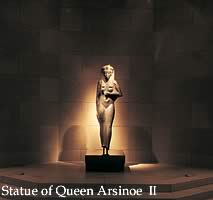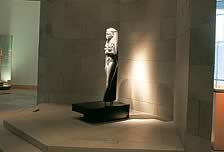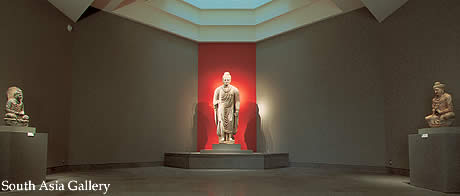
| Passing through a grove of peach blossoms in full bloom and through a cave, you arrive upon the village of the Peach Blossom Spring. What would you do if you were to create such a place? |
 |
When closely looking at Miho Museum, one notices that the building is primarily composed of two color schemes: the gentle honey tone of the limestone and louvers and the silver-grey hue of the space frames. Though the darker shades mostly accent the large light open spaces, grey subtly provides a striking ambience to the entrance area of the South Asian gallery. To one side of the gallery stands the Egyptian goddess Arsinoe, while on the other, a stone Gandharan Buddha. | |
| The grey stone used here to display these stunning images is pietra serena. The black feminine silhouette of Arsinoe stands out beautifully against her solemn grey sanctuary as if opening a mysterious passageway to ancient Egypt. In contrast, the Gandharan Buddha imposes a solitary presence. From his back, a ray of sunlight and burst of energy flow in from the ceiling transforming the calm ambience of the dimly lit space. | ||
| The surrounding wall, floor, and dais
upon which the Buddha stands, all made of pietra serena, evoke the
monastery where the Buddha was perhaps once enshrined. This stone
effectively recreates the dark, tranquil feel of a monastic cave,
while allowing the Buddha’s expression to fill the room with
warmth. |
 |
|
| The pietra serena appears to absorb everything―sound, light, heat, and cold―burying it deep within its gentle surface. I. M. Pei chose this gentle grey stone from Italy for these exhibition rooms. As a trial, he asked people to touch the pietra serena stone behind the statue of Arsinoe. Pei used the same acute angles that were favorably received at the National Gallery in Washington D.C. However, instead of light-colored marble, he incorporated this dark stone, which somehow produces a softer, subtle effect. The use of pietra serena, which continues to preserve the peaceful ambience of our museum, is another particular care that I. M. Pei took when designing Miho Museum. | ||

